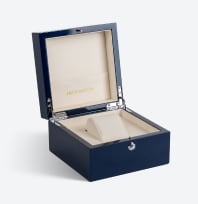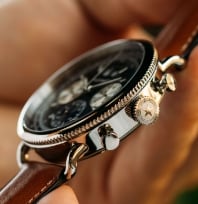Under The Surface Of A Watch, A Delicate, Intricate Mechanism Makes It Tick.
In order for a watch to keep time accurately, it needs a source of energy that it can store up to continue ticking. This source of energy is known as a watch’s movement. The most common types of watch movements are mechanical, automatic, and quartz. Each of these movements works differently, and there are pros and cons to wearing a watch that is powered by all of them.
This article will specifically focus on automatic watch movement, which can be described as something of a perpetual motion mechanism. Automatic watches are also known as self-winding watches due to their ability to store up energy via either a manual wind from the wearer or from a spinning rotor within the watch that allows it to wind itself.
As you read, you will learn how automatic watches work, how automatic movement compares to the other movement types, and why an automatic watch is worth looking into.
A Brief Introduction To Watch Movements
As you just learned, there are three primary types of watch movement – mechanical movement, automatic movement, and quartz movement. Below is a brief explanation of each:
- Mechanical movement is the oldest and most traditional method of making a watch tick. Inside a mechanical watch is a wide array of turning cogs which, when the watch is manually wound by the wearer, will continue turning at a precise rate to keep the watch ticking accurately.
Mechanical watches are often considered luxury items, and watchmaking has rightfully been deemed an art form, largely thanks to the expert craftsmanship behind mechanical watches.
- Quartz movement is a more recent method for powering watches. This type of watch movement relies on a battery which sends an electrical current through a piece of quartz inside the watch, vibrating at a precise frequency that keeps the watch’s hands ticking with great accuracy.
- An automatic watch, also known as a self-winding watch or perpetual motion watch, is powered by energy stored in the watch’s mainspring. The energy is generated by a weighted rotor that spins as the wearer’s wrist turns.
Automatic movement is a fascinating feat of human inventiveness, allowing a watch to keep ticking accurately without a battery or much interference from the wearer as long as it is worn consistently. An automatic watch can also be manually wound if necessary, something the wearer might have to do after going a long time without wearing the watch.
Each of these movement methods can be found in watches on the market today. However, since quartz and automatic movement are more recent inventions and typically provide the wearer with a more convenient, low-maintenance timekeeping experience, they have become significantly more popular over the past few decades.
Why Choose Analog Over Digital?
Digital watches are also a recent invention in the scheme of timekeeping history, and some appreciate them for the convenience of their easy-to-read interfaces. However, they simply do not compare to analog watches in terms of longevity and style. Analog watches have stood the test of time thanks to their stylish looks, functionality, and distinct ability to take outfits to the next level.
Digital watches have a tendency to make an outfit look much more casual, and they are not always completely inappropriate to wear. You won’t necessarily be committing a fashion faux pa by wearing a digital watch with some more casual looks.
However, a good analog watch is guaranteed to improve your look, boost your confidence and will last decades with proper care. Many analog watches can even be passed down through generations, making them extremely sentimental and special heirlooms. The same cannot be said for digital watches, which have already been rendered somewhat obsolete by the advent of smartwatches.
Regarding smartwatches, the same reasons listed above will make you want to choose analog. Smartwatches have some relatively convenient functions, to be sure. However, they tend to simply mirror the functionality of the other, larger device in your pocket (your smartphone).
While smartwatches can often be customized and personalized to make them look a bit more aesthetically pleasing, it is still difficult to get a smartwatch to look good with a dressy outfit. On the other hand, an analog watch is versatile enough to look excellent with a wide range of looks, never putting you at risk of making your outfit look tacky.
The History Of Automatic Watches
The technology that eventually gave birth to the automatic wristwatch is as old as the 18th century, before wristwatches were being sold and worn. These original automatic timepieces were pocket watches. Powered by the transfer of energy from the wearer handling them, these automatic pocket watches contained similar mechanisms to the ones that began being used to power automatic wristwatches in the early 20th century.
By the time World War I had ended, automatic wristwatches were becoming more common. These watches contained weights attached to a rotor that would spin, allowing energy to be stored in the watches’ mainsprings to keep them ticking consistently and accurately.
Later in the 20th century, luxury watchmakers began adding additional weights to the inner mechanisms of their automatic watches, allowing the wrist movements of a watch’s wearer to store up more power to be used by the watch. This change in the design was a significant improvement and eventually gave way to the use of weighted ball bearings that gave automatic watches the ability to keep time more accurately.
As of the 21st century, automatic watch movement is still a common power source for wristwatches, much more prevalent now than manual mechanical movement. However, in the later 20th century, quartz movement was introduced, offering a battery-powered alternative to manual and automatic watches.
The introduction of quartz movement gave watch wearers what is arguably the most low-maintenance watch wearing experience. Although not objectively superior to automatic or mechanical movement, the battery-powered quartz movement mechanism has become one of the most dominant power sources for watches in the last several decades.
Why Wear An Automatic Watch?
Automatic watches, as you now know, contain fascinating technology that allows them to work reliably with little interference from the wearer. The weighted mechanism in an automatic watch harnesses the wrist movements of the wearer. This makes for an extremely appealing wearing experience.
You can feel the weight of an automatic watch as you wear it, giving you a distinct sense of its quality and the craftsmanship behind it. This is a far different experience from strapping on a flimsy, lightweight digital watch or smartwatch, which feels like a kitschy gadget in comparison.
In addition, automatic watch movement can be found as the power source for many different types of watches. It is important to distinguish a watch’s movement from its type. The movement of a watch is not the primary method of categorizing the watch. Instead, a wristwatch will typically be branded under the umbrella of a specific design.
Some of the most common types of watches are field, dive, nautical, aviation, and racing watches. Each of these types of watches can be powered by any of the three major watch movements. When shopping for a new watch, looking at any potential watch’s movement type and its classification are two of the most important steps in determining whether it is right for you.
Ultimately, there is no inherently superior form of watch movement or type of watch. Many watch enthusiasts enjoy the experience of wearing an automatic watch, with its distinct weight and the convenience of its self-winding mechanism. However, others may prefer the lighter and lower-maintenance experience of wearing a quartz watch.
Likewise, the lasting appeal of mechanical watches due to the intricate craftsmanship behind each one has not been lost on watch wearers in the 21st century. There are selling points for each movement type in the same way that each style of watch is worth considering. It’s up to you to decide which one best fits your lifestyle and preferences.
When looking for an automatic watch that is best for you, taking your daily attire into account is a great place to start. If you are typically wearing more formal outfits for work and everyday life, an automatic dive watch is a great choice. Dive watches are versatile enough to wear with formal and casual looks and can even be worn with a tuxedo. A dive watch is a perfect option if you are planning on owning just one watch and want to be able to pair it with as many outfits as possible.
Make your decision on the best watch for you based on its movement, type, and its visual appeal to you. Covering these important bases, you can’t go wrong.
Sources:
https://www.thrillist.com/gear/things-you-have-to-explain-to-people-that-don-t-wear-watches
https://www.vogue.com/article/minimalist-wardrobe-guide-how-to
https://www.cosmopolitan.com/style-beauty/fashion/a5759/simple-ways-to-master-color-mixing/












